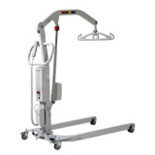Questions to consider before deciding on patient lift

Where do you need to use this lift?

If in a home: What rooms within the home? In a bathroom? In a bedroom? In a family room? Between multiple rooms? What type of flooring do you have? Carpet? Is there space available to operate a rolling patient lift and space to store it when not in use? Evaluate all potential tight areas. Does the bed have clearance under it for the legs of a rolling lift if necessary? What do you know about your ceiling construction?
If in a facility: In a ward? Between multiple rooms? What is the current injury rate for caregivers?
Describe the patient.
What is the patient's weight and height? What is their condition -- things that might relate to lifting them? Do they need head support? Do they need access to a commode? Do they have sensitive skin? Any restrictions to bending? Do you ever need to lower patient to or lift patient from the floor for therapy or after a fall? Is the patient always assisted?
Who are the caregivers?
How strong are they? (Do we have a 120 pound caregiver caring for a 200 pound patient?) They will need to become familiar with the operation of the new lift.
What types of lift movements does patient need to be able to accomplish?
Bed to Chair or Toilet or Tub or Floor and back? Chair to Bed or Toilet or Tub or Floor and back? To/from floor for therapy or in case patient has fallen? Sit to Stand? Repositioning the patient in their chair or bed?
Any special needs/restrictions/ applications?
Gait Training? Rolling or otherwise re-positioning the patient in bed? Patient unable to sit? Want to use to visit family members or travel using hotels?
Patient Lift Considerations
Caregiver Injury
Preventing caregiver injury is a driving force in the purchase/use of patient lifts. Even highly skilled facility caregivers can injure themselves by overexertion and strain. While the use of manual (hydraulic) lifts is a step in the direction of caregiver safety, they still require caregiver exertion. Power-assisted patient lifts are the answer to preventing caregiver injury.
Know the types of lifts available
There are many types of lifts available. The primary classes of lifts are:
- Ceiling - Ceiling lifts run on "tracks" installed in the ceiling of your home/facility. They are the most versatile, convenient and least obtrusive types of lifts. Within the ceiling lift class of lift, there are installed lifts and portable lifts.
- Floor (Rolling) - Floor model lifts roll on casters and are designed to perform different functions.
Slings
Whether you choose a ceiling or floor lift, the patient will be lifted in a sling attached to the lift. There are many different slings available. Just to give you an idea, we have an entire page devoted to slings. We'll also help you determine the proper sling.
Track Ceiling Lifts
Track Ceiling lifts travel from point to point or room to room on a track installed in your ceiling. The track can be as short as a 6 foot piece of track over the bed and wheelchair area or as involved as track all over a home or facility. This track can be straight or curved and can have a variety of accessories to help your patient get where they need to within your home or facility.


